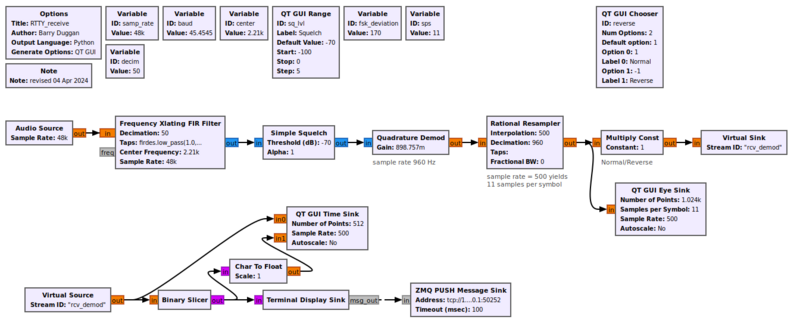This can be used to demod FM, FSK, GMSK, etc. The input is complex
baseband, output is the signal frequency in relation to the sample
rate, multiplied with the gain.
Mathematically, this block calculates the product of the one-sample
delayed-&-conjugated input and the undelayed signal, and then calculates
the argument (a.k.a. angle, in radians) of the resulting complex number:
![{\displaystyle y[n]=\mathrm {arg} \left(x[n]\,{\bar {x}}[n-1]\right)}](https://en.wikipedia.org/api/rest_v1/media/math/render/svg/84c630130d2bec382313f6da607e7df434cc7613)
Let x be a complex sinusoid with amplitude A>0, (absolute)
frequency  and phase
and phase ![{\displaystyle \phi _{0}\in [0;2\pi ]}](https://en.wikipedia.org/api/rest_v1/media/math/render/svg/83317d39f55e8bd895248ce082aa5b5dac28adb5) sampled at
f_s>0 so, without loss of generality,
sampled at
f_s>0 so, without loss of generality,
![{\displaystyle x[n]=Ae^{j2\pi ({\frac {f}{f_{s}}}n+\phi _{0})}}](https://en.wikipedia.org/api/rest_v1/media/math/render/svg/7480ee4b1d7e60697cc5c58bd0e033bcb0be868b)
then
![{\displaystyle y[n]=\mathrm {arg} \left(Ae^{j2\pi \left({\frac {f}{f_{s}}}n+\phi _{0}\right)}{\overline {Ae^{j2\pi ({\frac {f}{f_{s}}}(n-1)+\phi _{0})}}}\right)\ =\mathrm {arg} \left(A^{2}e^{j2\pi \left({\frac {f}{f_{s}}}n+\phi _{0}\right)}e^{-j2\pi ({\frac {f}{f_{s}}}(n-1)+\phi _{0})}\right)\ =\mathrm {arg} \left(A^{2}e^{j2\pi \left({\frac {f}{f_{s}}}n+\phi _{0}-{\frac {f}{f_{s}}}(n-1)-\phi _{0}\right)}\right)\ =\mathrm {arg} \left(A^{2}e^{j2\pi \left({\frac {f}{f_{s}}}n-{\frac {f}{f_{s}}}(n-1)\right)}\right)\ =\mathrm {arg} \left(A^{2}e^{j2\pi \left({\frac {f}{f_{s}}}\left(n-(n-1)\right)\right)}\right)\ =\mathrm {arg} \left(A^{2}e^{j2\pi {\frac {f}{f_{s}}}}\right)}](https://en.wikipedia.org/api/rest_v1/media/math/render/svg/cd12a233f670bb1276175b55b2fed0d7394085ba)
 is real, and so is
is real, and so is  , and hence only scales, therefore
, and hence only scales, therefore  is invariant: = arg
is invariant: = arg 
This block does not support C++ output, so it cannot be used when the output language of a flowgraph in GRC is C++.
Parameters
- Gain
- Gain setting to adjust the output amplitude. Set based on converting the phase difference between samples to a nominal output value. Default: "samp_rate/(2*math.pi*fsk_deviation_hz)".
Example Flowgraph
This flowgraph shows the Quadrature Demod block as a Frequency Shift Keying detector.

Source Files
- C++ files
- [1]
- Header files
- [2]
- Public header files
- [3]
- Block definition
- [4]
![{\displaystyle y[n]=\mathrm {arg} \left(x[n]\,{\bar {x}}[n-1]\right)}](https://en.wikipedia.org/api/rest_v1/media/math/render/svg/84c630130d2bec382313f6da607e7df434cc7613)

![{\displaystyle \phi _{0}\in [0;2\pi ]}](https://en.wikipedia.org/api/rest_v1/media/math/render/svg/83317d39f55e8bd895248ce082aa5b5dac28adb5)
![{\displaystyle x[n]=Ae^{j2\pi ({\frac {f}{f_{s}}}n+\phi _{0})}}](https://en.wikipedia.org/api/rest_v1/media/math/render/svg/7480ee4b1d7e60697cc5c58bd0e033bcb0be868b)
![{\displaystyle y[n]=\mathrm {arg} \left(Ae^{j2\pi \left({\frac {f}{f_{s}}}n+\phi _{0}\right)}{\overline {Ae^{j2\pi ({\frac {f}{f_{s}}}(n-1)+\phi _{0})}}}\right)\ =\mathrm {arg} \left(A^{2}e^{j2\pi \left({\frac {f}{f_{s}}}n+\phi _{0}\right)}e^{-j2\pi ({\frac {f}{f_{s}}}(n-1)+\phi _{0})}\right)\ =\mathrm {arg} \left(A^{2}e^{j2\pi \left({\frac {f}{f_{s}}}n+\phi _{0}-{\frac {f}{f_{s}}}(n-1)-\phi _{0}\right)}\right)\ =\mathrm {arg} \left(A^{2}e^{j2\pi \left({\frac {f}{f_{s}}}n-{\frac {f}{f_{s}}}(n-1)\right)}\right)\ =\mathrm {arg} \left(A^{2}e^{j2\pi \left({\frac {f}{f_{s}}}\left(n-(n-1)\right)\right)}\right)\ =\mathrm {arg} \left(A^{2}e^{j2\pi {\frac {f}{f_{s}}}}\right)}](https://en.wikipedia.org/api/rest_v1/media/math/render/svg/cd12a233f670bb1276175b55b2fed0d7394085ba)




